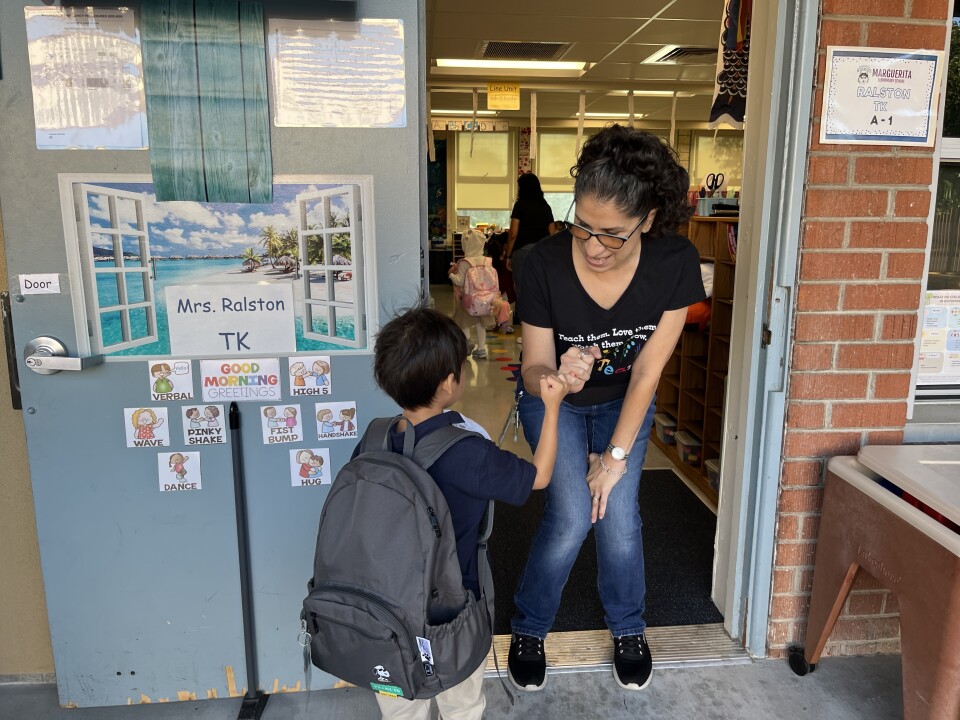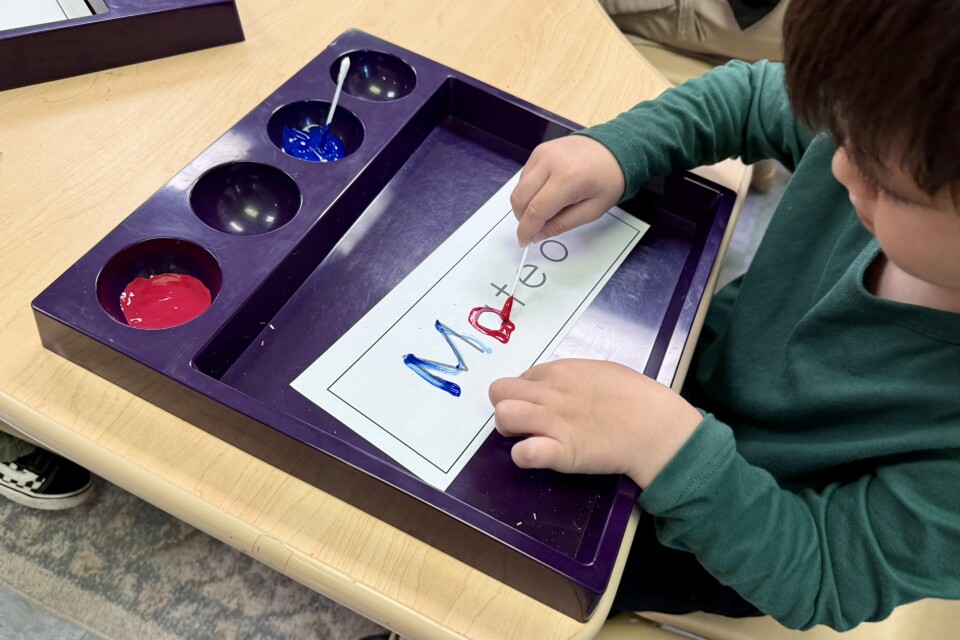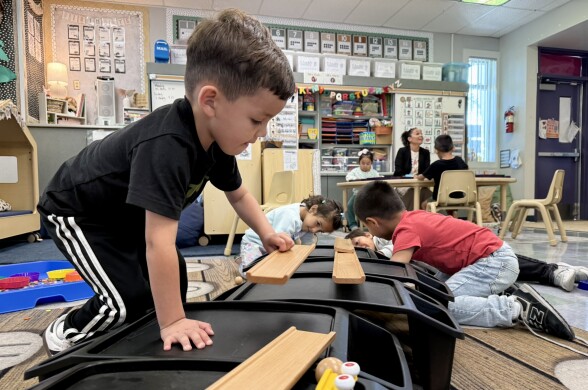Truth matters. Community matters. Your support makes both possible. LAist is one of the few places where news remains independent and free from political and corporate influence. Stand up for truth and for LAist. Make your year-end tax-deductible gift now.
California schools now offer free preschool for 4-year-olds. Here's what kids really learn in it

Every 4-year-old in California can now go to school for free in their local districts. The new grade is called transitional kindergarten — or TK — and it's part of the state’s effort to expand universal preschool.
In 2021, Gov. Gavin Newsom and the state legislature moved to expand transitional kindergarten in a $2.7 billion plan so that all 4-year-olds could attend by the 2025-26 school year. (Prior to this, TK was only available for kids who missed the kindergarten age cutoff by a few months). While it’s not mandatory for students to attend, districts must offer them as an alternative to private preschool.
As a free option, it can save parents a lot of money. Parents also must weigh how sending their kids into a school-based environment compares to a preschool they might already know and like, as well as other needs like all-day care, and how much play their child does.
One big question we’ve heard: What do kids actually do and learn in a TK classroom? Educators say it’s intended to emphasize play, but what does that mean?

To help parents get a better sense of this new grade as they make their decisions, LAist reporters spent the day in three different classrooms across the Southland. Here are five things we saw children do.
Get used to the structure and routines of school
For many students, transitional kindergarten is their first introduction to a formal school preschool setting. Crystal Ramirez sent her 4-year-old to TK at Marguerita Elementary School in Alhambra, so he could get used to the rhythm and rigors of school.
“I didn't wanna put him straight into kindergarten when he was five, six, so he at least knows a routine, already,” she said. “Now, as soon as he sees that we’re in school, he loves it.”
TK students, like other elementary school students, follow a schedule: morning bell, recess, lunch, second recess and dismissal. They’re also learning how to listen to instructions or stand in a line. Some are learning to go to the cafeteria for lunch.

“ I wanna make sure that their first experience in a public school setting is one that is joyful, where they feel loved, where they feel welcomed, where they get to really transition nicely into like the rigor of the school,” said Lauren Bush, a TK teacher at Lucille Smith Elementary in Lawndale.
Claudia Ralston, a TK teacher at Marguerita Elementary, said it can be hard for young kids to get up early and leave their moms and dads. But seven weeks in, many of her students have learned their routines already. She helps with the morning transitions by turning on soft instrumental music in the classroom, and allowing them free play until they regroup on the mat to discuss the day.
“They're four years old. I want them to feel safe at school, know that this is a special place for learning and that they play,” she said.
Learn how to socialize and communicate
In TK, social-emotional learning is a big part of the curriculum. That’s a fancy word, but it just means they’re learning how to be in touch with their emotions
At Price Elementary in Downey, the teacher has her kids give an affirmation: "I am safe. I am kind. I matter. I make good choices. I can do hard things. All of my problems have solutions!" (They also have these sentences on classroom wall signs.)
The children also learn how to interact with their peers. In some schools, there are no assigned desks so the kids can learn how to share the space.
“ They're able to problem solve. They're able to use communication to get their needs, regulating their emotions. They do better than students who come in without this experience,” said Cristal Moore, principal at Lucille Smith Elementary.
On the playground, a student named Ava told teacher assistant Lizbeth Orozco that another student pushed her.
“How did that make you feel?” Orozco asked.
“Mad!”
Orozco encouraged Ava to express her feelings to her classmate.
“ We give them options of how to solve a problem and then they go in and solve it themselves,” Orozco said. “If they need extra help, they always come back and we can help them.”
Arguing over toys can be a common occurrence in a TK classroom. At Price Elementary in Downey, educators help kids work through a solution. On a recent morning, one 4-year-old used two tongs to pick up paper shapes in a sensory bin, leaving another kid upset.
“What’s the rule about sharing?” asked Alexandria Pellegrino, a teacher who gives extra support for one TK classroom.
The boy handed over a tong to his peer. “Thank you so much for being a good friend,” Pellegrino said.

“[It’s] about being kind friends and making friends and using our manners. So we do build that foundation at the beginning of the year,” said Samantha Elliot, the classroom’s lead instructor.
At the end of the day in Alvarez’s Lawndale TK class, she counts up the stars next to each student’s name earned throughout the day — earned for positive behavior like being kind, solving problems, trying something challenging, or showing effort in other ways. Ten stars earns a small prize from the treasure chest.
“If we don’t get something today are we going to get mad?” Alvarez asked the class.
“No!” they responded.
“I’m not going to cry!” one boy piped up, followed by his classmate and a “Me too!” from another student.
“That’s [a] positive attitude,” Alvarez said. “Because tomorrow you can get more stars!”
Support LAist today
Get exposed to numbers, shapes, letters
In Elliot’s TK class, students use their own little lightsabers to trace letters in the air.
“They're learning the letter, the sound, and then a little action to go with it. They're wiggling and moving and they're also learning those letter sounds and they don't really realize, so it's incorporating instruction,” she said.

There’s no mandated curriculum in TK, but instruction is supposed to align with the state’s Preschool/Transitional Kindergarten Learning Foundations. “Kindergarten is basically where the state standards go and kick in. There are standards in TK, but it's a little bit different,” said Tom Kohout, principal at Marguerita Elementary.
Students might put playdough into letter molds, or the teacher might pull out toys from a bag that all start with a letter “E.” Kids will play with little plastic toys that connect — or “manipulatives” — that can help them recognize numbers and patterns.
“It’s play with a purpose,” Ralston said. “They're just being introduced to the numbers, the colors, writing. But again, we're not doing worksheets.”
Build fine motor skills
Molding pretend cakes with kinetic sand. Connecting small LEGO bricks. Cutting playdough. It might not seem like much, but children this age are still learning how to use their bodies.
“Tearing paper is really hard and it's a really amazing fine motor skill for them because the same muscles you use to tear paper are the same muscles that you use to hold a pen or a pencil,” said Lauren Bush, a TK teacher at Lucille Smith Elementary in Lawndale.
“You see kids playing with dinosaurs. I see kids sorting by color, doing visual, you know, eye hand coordination and visual discrimination. I see them using their fine motor skills,” she said.
At lunch, kids learn how to open up a milk carton or open a packaged muffin. At PE, they learn to balance on a block or walk in a straight line — learning spatial awareness.
“They’re learning how to run, stop, things like that and playing because their bodies are so young,” said Principal Kohout.
Learn independence
For some kids, it might be the first time where mom and dad aren't there to help carry their backpacks or help them go to the bathroom. TK is meant to help focus on their independence, though aides can help.
TK classrooms are also usually set up with play centers, so kids can have the choice to explore on their own.
“ I want them to be independent, to be able to solve their problems, you know, with assistance,” Ralston said.
Samantha Elliot, the TK teacher in Downey, says she encourages kids to talk to their teammates first to figure out an activity before going to a teacher.
“It's just gaining the confidence and building that independence from basically the start of the school year,” she said.
Parent Crystal Ramirez has already noticed a change in her 4-year-old this year since starting school. “ [He’s] socializing a little bit more, talking a little bit more, trying to express himself as well.”













